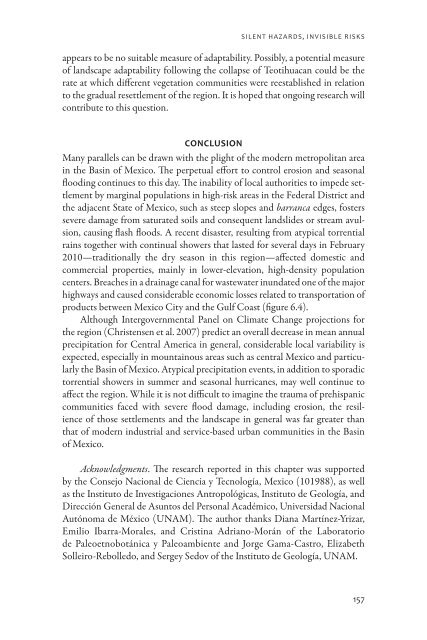free download - University Press of Colorado
free download - University Press of Colorado
free download - University Press of Colorado
Create successful ePaper yourself
Turn your PDF publications into a flip-book with our unique Google optimized e-Paper software.
Silent Hazards, Invisible Risks<br />
appears to be no suitable measure <strong>of</strong> adaptability. Possibly, a potential measure<br />
<strong>of</strong> landscape adaptability following the collapse <strong>of</strong> Teotihuacan could be the<br />
rate at which different vegetation communities were reestablished in relation<br />
to the gradual resettlement <strong>of</strong> the region. It is hoped that ongoing research will<br />
contribute to this question.<br />
Conclusion<br />
Many parallels can be drawn with the plight <strong>of</strong> the modern metropolitan area<br />
in the Basin <strong>of</strong> Mexico. The perpetual effort to control erosion and seasonal<br />
flooding continues to this day. The inability <strong>of</strong> local authorities to impede settlement<br />
by marginal populations in high-risk areas in the Federal District and<br />
the adjacent State <strong>of</strong> Mexico, such as steep slopes and barranca edges, fosters<br />
severe damage from saturated soils and consequent landslides or stream avulsion,<br />
causing flash floods. A recent disaster, resulting from atypical torrential<br />
rains together with continual showers that lasted for several days in February<br />
2010—traditionally the dry season in this region—affected domestic and<br />
commercial properties, mainly in lower-elevation, high-density population<br />
centers. Breaches in a drainage canal for wastewater inundated one <strong>of</strong> the major<br />
highways and caused considerable economic losses related to transportation <strong>of</strong><br />
products between Mexico City and the Gulf Coast (figure 6.4).<br />
Although Intergovernmental Panel on Climate Change projections for<br />
the region (Christensen et al. 2007) predict an overall decrease in mean annual<br />
precipitation for Central America in general, considerable local variability is<br />
expected, especially in mountainous areas such as central Mexico and particularly<br />
the Basin <strong>of</strong> Mexico. Atypical precipitation events, in addition to sporadic<br />
torrential showers in summer and seasonal hurricanes, may well continue to<br />
affect the region. While it is not difficult to imagine the trauma <strong>of</strong> prehispanic<br />
communities faced with severe flood damage, including erosion, the resilience<br />
<strong>of</strong> those settlements and the landscape in general was far greater than<br />
that <strong>of</strong> modern industrial and service-based urban communities in the Basin<br />
<strong>of</strong> Mexico.<br />
Acknowledgments. The research reported in this chapter was supported<br />
by the Consejo Nacional de Ciencia y Tecnología, Mexico (101988), as well<br />
as the Instituto de Investigaciones Antropológicas, Instituto de Geología, and<br />
Dirección General de Asuntos del Personal Académico, Universidad Nacional<br />
Autónoma de México (UNAM). The author thanks Diana Martínez-Yrizar,<br />
Emilio Ibarra-Morales, and Cristina Adriano-Morán <strong>of</strong> the Laboratorio<br />
de Paleoetnobotánica y Paleoambiente and Jorge Gama-Castro, Elizabeth<br />
Solleiro-Rebolledo, and Sergey Sedov <strong>of</strong> the Instituto de Geología, UNAM.<br />
157





